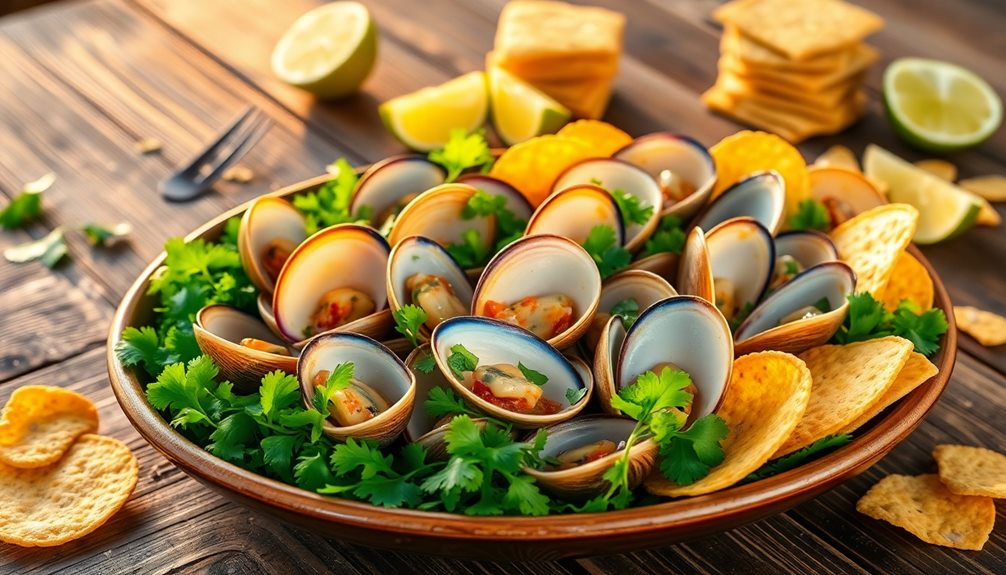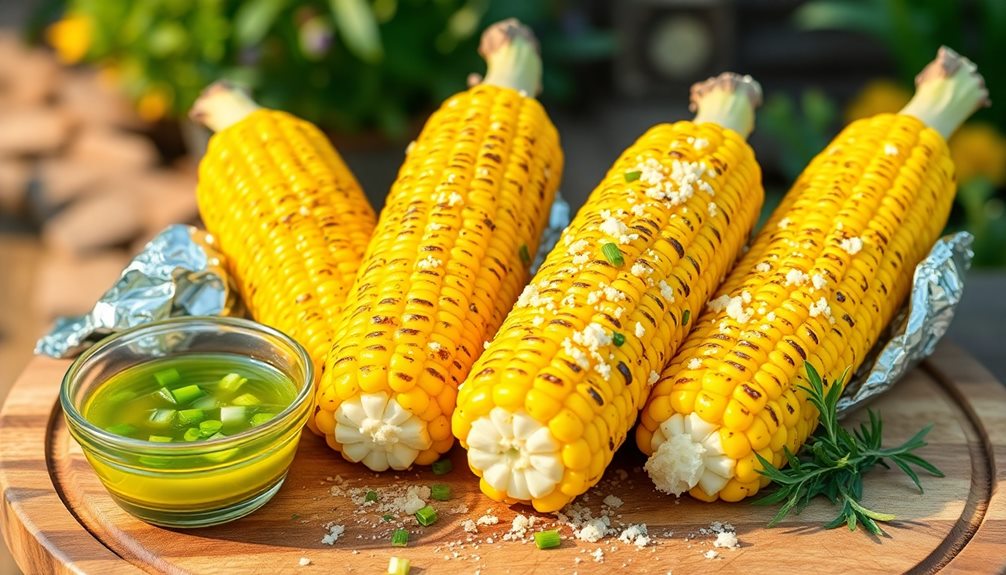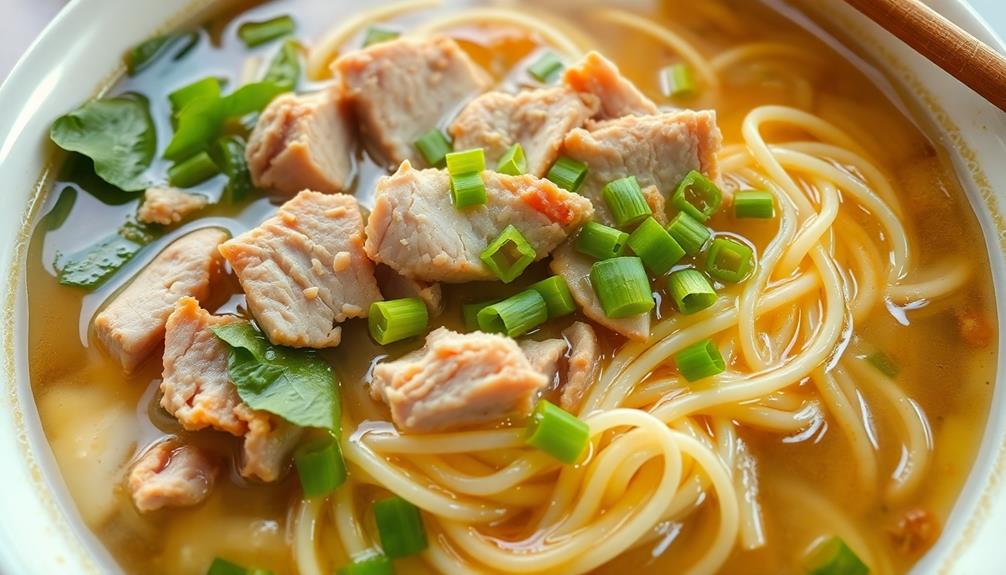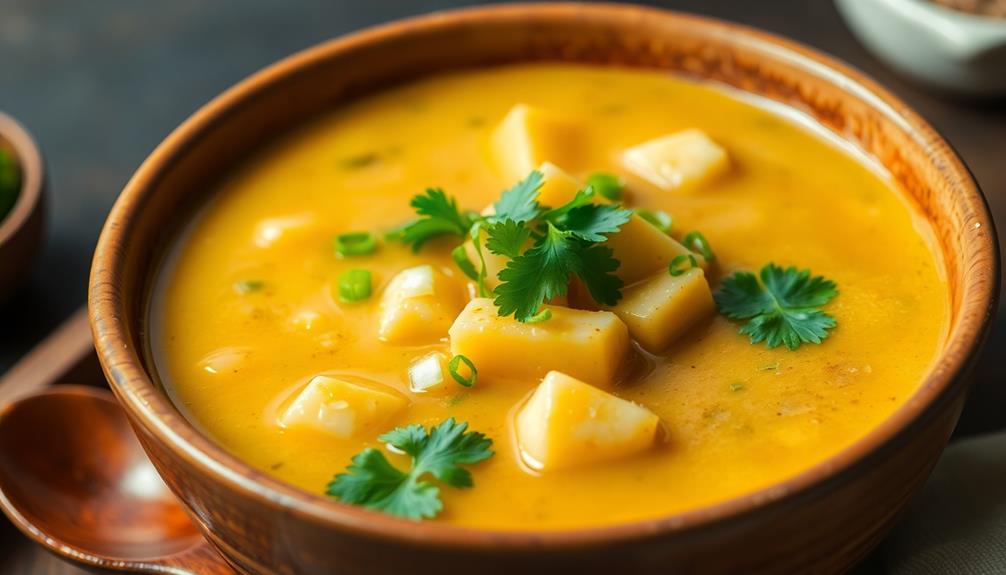Bun Mang Vit, the beloved Vietnamese duck and bamboo noodle soup, transports you to the bustling streets of Vietnam. This treasured dish blends French culinary techniques with local Vietnamese flavors, creating a delightful balance of savory broth, tender duck meat, and chewy bamboo shoots. Cherished as a comfort food and served at special gatherings, Bun Mang Vit is a heart-warming experience. Key ingredients like star anise and fresh herbs enhance the aromatic broth, while lime adds a zesty kick. Slurping the noodles is a traditional way to enjoy this beloved dish. If you'd like to learn more about the cultural significance and preparation of this Vietnamese classic, read on.
Key Takeaways
- Bun Mang Vit is a Vietnamese comfort food dish that combines tender duck meat, chewy bamboo shoots, and aromatic spices in a savory broth.
- The dish originated during the French colonial period, blending French culinary techniques with local Vietnamese ingredients.
- The broth is simmered for hours to develop a rich, flavorful profile, and the dish is often garnished with fresh herbs, lime, and chili peppers.
- Bun Mang Vit is a beloved staple in Vietnamese cuisine, frequently served at celebrations and enjoyed for its heartwarming qualities.
- The dish provides a balance of nutrients, including protein from the duck, fiber from the bamboo shoots, and vitamins from the fresh herbs.
History

The origins of Vietnamese Duck and Bamboo Noodle Soup can be traced back to the early 20th century, when French colonization introduced new culinary influences to the region.
These exotic flavors quickly captured the hearts and palates of the Vietnamese people, who began experimenting with the fusion of French techniques and local ingredients.
As the dish evolved, it became a beloved staple, cherished for its delicate balance of savory broth, tender duck meat, and the unique texture of bamboo shoots.
The noodles, made from rice flour, provided a comforting base, while the fragrant herbs and spices elevated the dish to new heights.
Today, Bun Mang Vit remains a treasured part of Vietnamese cuisine, often served during celebratory occasions and family gatherings.
The combination of rich, flavorful broth and the satisfying chewiness of the noodles is a true delight, evoking feelings of warmth and nostalgia in all who savor this timeless dish.
Recipe
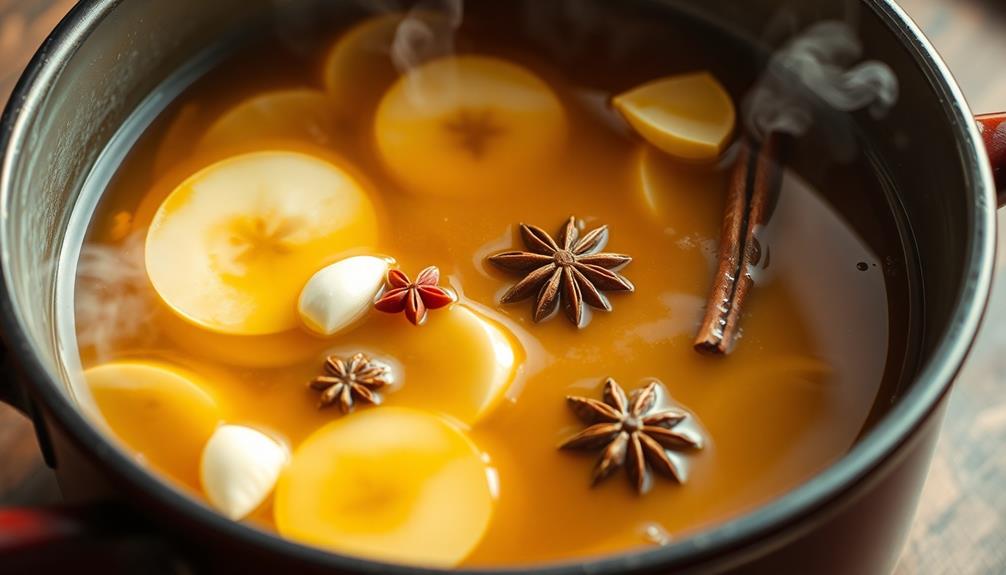
Vietnamese Duck and Bamboo Noodle Soup is a delightful and aromatic dish that combines the rich flavors of duck with the delicate texture of bamboo noodles. This comforting soup is a beloved staple in Vietnamese cuisine, offering a harmonious blend of savory and refreshing elements.
The key to this dish lies in the careful preparation of the broth. By simmering the duck carcass and aromatics for an extended period, you'll extract a deep, complex flavor that forms the foundation of the soup. The addition of bamboo noodles adds a unique and satisfying texture, perfectly complementing the tender duck meat.
Ingredients:
- 1 whole duck, cut into pieces
- 8 cups of water
- 3 cloves of garlic, minced
- 1 onion, sliced
- 2 inches of ginger, sliced
- 2 star anise
- 2 cinnamon sticks
- 1 tablespoon of fish sauce
- 1 tablespoon of brown sugar
- Salt and pepper to taste
- 8 ounces of bamboo noodles
- Chopped green onions and cilantro for garnish
Instructions:
In a large pot, combine the duck pieces, water, garlic, onion, ginger, star anise, and cinnamon sticks. Bring the mixture to a boil, then reduce the heat and let it simmer for 2-3 hours, skimming off any foam or fat that rises to the surface.
Once the broth has developed a rich, flavorful profile, add the fish sauce, brown sugar, and season with salt and pepper to taste.
Additional Tips:
To enhance the flavors, you can roast the duck pieces before adding them to the broth, which will create a deeper, more complex taste.
Additionally, you can experiment with different types of noodles, such as rice noodles or vermicelli, to suit your preferences.
Garnishing the dish with freshly chopped green onions and cilantro will add a vibrant and aromatic touch to the final presentation.
Cooking Steps
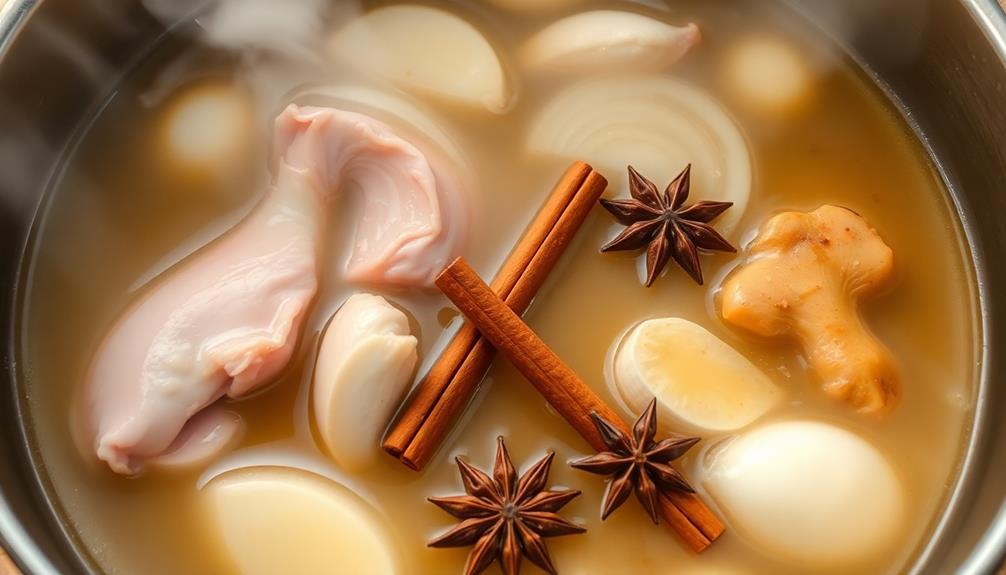
Gather all the necessary ingredients like fresh duck, rice noodles, and aromatic herbs.
Then, prepare the bamboo shoots and herbs, getting them ready for the flavorful broth.
Step 1. Gather All Necessary Ingredients

To get started, you'll need to round up a few key ingredients for this Vietnamese duck and bamboo noodle soup. First, you'll want to grab some fresh duck meat, either whole or as parts like the legs and thighs.
Don't forget the bamboo shoots – they'll add a delightful crunch to your soup! You'll also need some rice noodles, which will soak up all that flavorful broth.
Next, gather up your aromatics, like ginger, garlic, and shallots. These will infuse your soup with mouth-watering aromas.
Don't skimp on the fresh herbs either – cilantro, mint, and Thai basil will brighten up the dish. Oh, and you'll need some fish sauce, lime juice, and a bit of sugar to balance out the flavors.
Once you've got everything together, you'll be ready to start cooking up this authentic Vietnamese delight! Just follow the steps, and you'll have a warm, comforting bowl of bun mang vit in no time.
Step 2. Prepare Bamboo Shoots and Herbs

First, prepare the bamboo shoots. Rinse the fresh bamboo shoots under cold running water to remove any dirt or debris. Slice the bamboo shoots into thin strips, about 2 inches long. This will help them cook quickly and absorb all the delicious flavors!
Next, pick the fresh herbs. Gently pluck the leaves from the stems of the cilantro, mint, and Thai basil. Tear the leaves into bite-sized pieces to release their aromatic oils. The combination of these vibrant herbs will add a lovely freshness to your Vietnamese noodle soup.
Finally, thinly slice the scallions, including the green tops. The crisp, oniony flavor of the scallions will perfectly complement the rich broth and tender duck.
With the bamboo shoots, herbs, and scallions prepared, you're one step closer to enjoying this authentic and comforting Vietnamese dish. Get ready for your taste buds to be delighted!
Step 3. Prepare Broth by Simmering
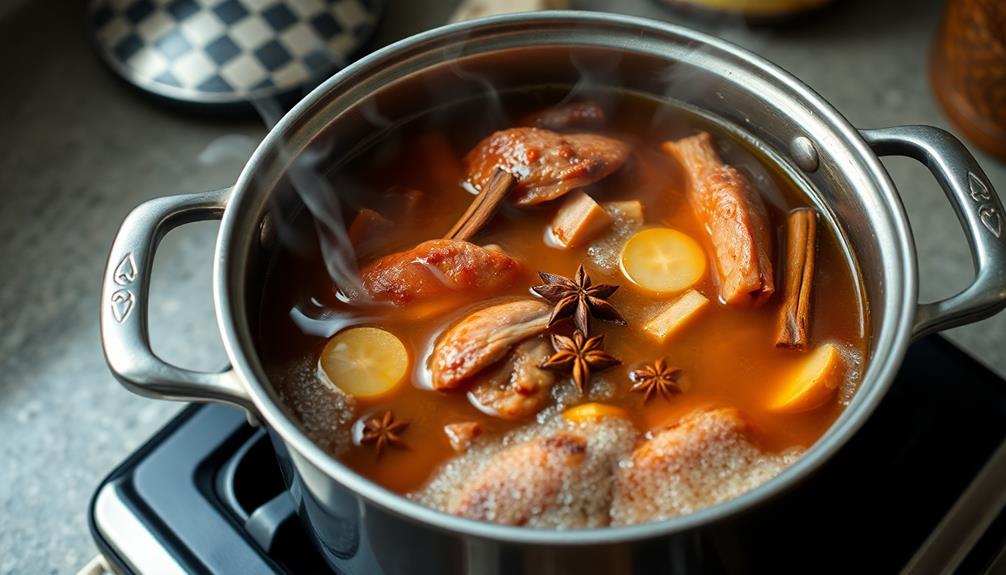
Bring the duck broth to a gentle simmer in a large pot. Let the fragrant broth gently bubble, infusing the flavors together.
Add the prepared bamboo shoots, allowing them to soften and soak up the tasty duck essence. Toss in the fresh herbs, like aromatic cilantro and spicy Thai basil, to brighten the soup.
Simmer everything for about 15 minutes, until the flavors have melded beautifully.
Now, it's time to taste and season your masterpiece! Add a pinch of salt and a drizzle of fish sauce to balance the sweetness. If you'd like a little zing, stir in a squeeze of fresh lime juice.
Once the broth is seasoned to perfection, it's ready to serve! Ladle the steaming hot soup into bowls and top it off with the tender, juicy duck meat.
Finish with a sprinkle of chopped green onions for a vibrant, festive touch.
Step 4. Add Duck Meat
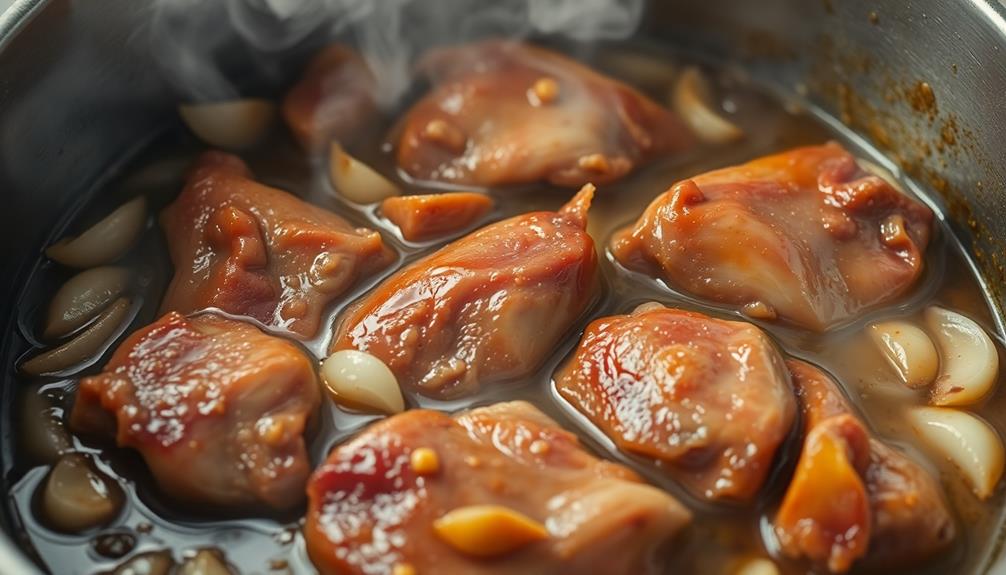
Once the broth has simmered and the flavors have melded, gently add the precooked duck meat to the pot. The tender, juicy duck will instantly infuse the soup with its rich, aromatic essence.
Stir the meat carefully, ensuring it's evenly distributed throughout the steaming liquid. As the duck warms through, breathe in the captivating scents wafting from the pot – savory, earthy, and irresistibly inviting.
This is the moment when the dish truly comes alive, the harmonious blend of flavors dancing on your palate.
Now, ladle the hearty soup into bowls, making sure each portion contains a satisfying amount of duck.
Top it off with the tender bamboo shoots, fragrant herbs, and a squeeze of fresh lime juice.
Get ready for an explosion of textures and tastes that will have your taste buds doing a happy dance!
Step 5. Assemble and Serve Soup

To assemble the soup, ladle the hot broth into serving bowls, making sure to include a generous portion of the tender duck meat.
Top each bowl with a generous serving of the chewy bamboo noodles. Garnish the soup with a sprinkle of fresh herbs, like fragrant cilantro and Thai basil. Add a squeeze of fresh lime juice for a bright, tangy flavor.
Next, set out an array of tasty toppings for everyone to customize their soup. Offer sliced green onions, crunchy bean sprouts, and spicy chili peppers. A sprinkle of crushed peanuts or fried shallots adds a wonderful crunch. Don’t forget to include fresh herbs like cilantro or Thai basil to bring a burst of vibrant flavor. For a richer experience, a dollop of creamy coconut milk or a splash of tangy lime juice can take things to the next level. These additions pair beautifully with earthy and nutty cassava leaf soup, elevating the dish to an unforgettable meal.
Invite your family to dig in and enjoy the delightful combination of savory duck, earthy bamboo, and aromatic herbs.
The vibrant colors and textures create a truly memorable Vietnamese dining experience. Slurp up the nourishing broth and savor the complex flavors in every bite. This heartwarming soup is sure to delight and satisfy.
Final Thoughts
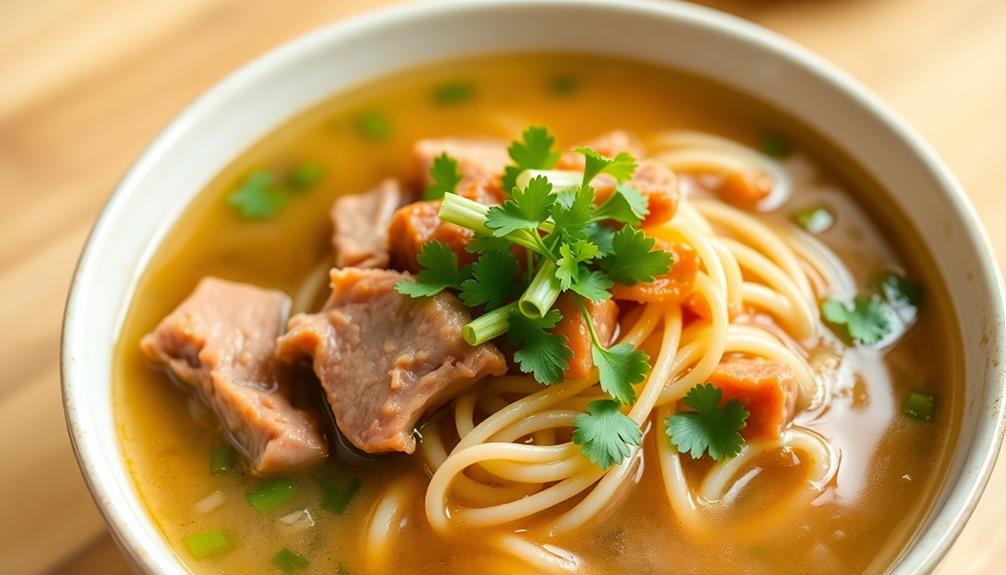
This fragrant Vietnamese duck and bamboo noodle soup leaves a lasting impression, inviting you to savor the depth of flavors and the comforting warmth it provides.
The rich, savory broth, infused with fragrant lemongrass and star anise, is the foundation of this dish, while the tender duck meat and chewy bamboo shoots offer a delightful contrast in textures.
The aromatic garnishes, such as fresh herbs, bean sprouts, and a squeeze of lime, elevate the soup, creating a harmonious balance of flavors that dance on your palate.
As you slurp up the noodles and sip the flavorful broth, you'll be transported to the bustling streets of Vietnam, where this beloved dish is a beloved comfort food.
Whether enjoying it on a chilly day or as a satisfying meal any time, Bun Mang Vit is sure to become a new family favorite, bringing joy and warmth to your table.
Frequently Asked Questions
Can I Substitute Chicken for Duck in This Recipe?
You can certainly substitute chicken for duck in this recipe. The flavors will be a bit different, but the overall dish will still be delicious. Give it a try and see what you think!
How Long Do the Noodles Typically Take to Cook?
The noodles typically take 5-7 minutes to cook, depending on the thickness and preparation method. You'll want to follow the package instructions and taste them periodically to ensure they reach your desired texture.
Is the Bamboo Shoot Taste Overpowering in This Dish?
The bamboo shoot taste isn't overpowering – it's a subtle, earthy accent that complements the other flavors. You'll enjoy its gentle crunch and mild flavor without it dominating the dish.
Can I Find All the Ingredients at a Regular Grocery Store?
You can likely find most of the ingredients for this dish at a regular grocery store, such as the noodles, broth, and duck. However, the bamboo shoots may be more challenging to locate and you may need to visit an Asian market.
Is This Dish Traditionally Served With Any Specific Condiments?
Yes, this dish is traditionally served with a variety of condiments. You'll typically find chili sauce, fish sauce, lime wedges, and fresh herbs like cilantro, mint, and basil on the side to customize the flavor.


